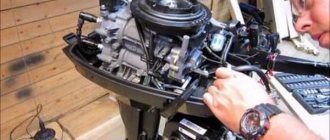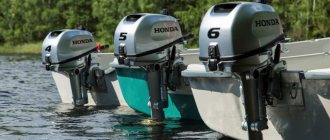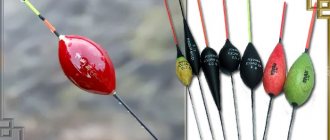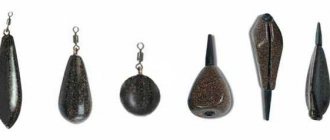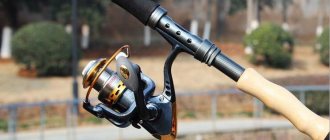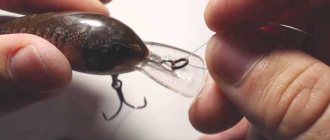Article updated: 05.11.2020
For autonomous power supply of a boat electric motor, navigation instruments, lighting devices and other energy-dependent equipment on water equipment, a traction battery is required. It must be designed for harsh operating conditions, withstand strong vibration, and not be afraid of deep discharges and moisture.
Important parameters when choosing a battery for an electric boat motor are:
- electric motor traction;
- weight of the boat or boat;
- features of the reservoir;
- fishing style and conditions;
- weight and dimensions of the battery - the lighter and more compact the battery, the more convenient it is to use;
- capacity – the battery life of the electric motor and additional equipment on 1 battery charge depends on it;
- provided cruising range - it depends on the battery capacity and the power of all devices on the ship;
- voltage - it can be 12, 24, 36 or 48 Volts;
- ease of transportation, storage and use;
- ability to work with strong pitching;
- the presence of a sealed housing that is resistant to mechanical damage;
- ability to work in a wide temperature range;
- resistance to temperature fluctuations;
- safety of use;
- maintenance requirements – the best choice would be sealed batteries that do not require maintenance;
- self-discharge level - it should be minimal to eliminate the risk of deep battery discharge during storage.
What kind of battery is needed for a boat motor?
The selection of a battery for an electric boat motor is carried out according to 3 main parameters: manufacturing technology, output power and capacity. Based on the electrode manufacturing technology, rechargeable batteries are divided into traction, starter and universal. Batteries of all types are used on boats, but the advisability of their use depends on the type of engine and operating mode of the battery.
Let's take a closer look at each type of battery:
- Traction batteries are deep-discharge batteries, designed for stable cyclic operation in charge-discharge mode. They are designed for long-term use, release accumulated energy to the maximum, produce stable current and resist oxidation. Depending on the chemical composition, they can withstand 500–1000 operating cycles or more. It is traction batteries that are designed for intensive use in cyclic mode and frequent deep discharges, so they are excellent for powering boats and other electric motors.
- Starter batteries are batteries designed for short-term supply of high currents. They provide quick start of a diesel or gasoline engine, but are not suitable for use in constant energy output mode. Under prolonged loads, starter batteries quickly lose their charge and fail prematurely. On boats, cutters, catamarans and yachts, they are used only to temporarily power the internal combustion engine at the time of its startup.
- Universal (dual-use) – models that can operate in both modes. They produce a high starting current, but can also be used in charge-discharge mode as a constant power source.
What happens if you use a car battery on a boat?
Car batteries are starter-type power supplies designed to provide short-term starting current. When used as intended, they serve faithfully for years. But when they are used in continuous DC mode and brought to deep discharges, car batteries quickly become unusable.
How long a car battery will last depends on the intensity of its use. As a rule, a new battery lasts for half a season or a season, most often for 5–7 charging cycles. Therefore, a car battery should only be used in combination with a fuel-powered engine. And the electric motor needs a traction battery or a universal dual-purpose model.
How to determine how long it will last on one charge
It would seem that the task is elementary. Let's assume we have a 12-volt battery with a capacity of 60 Ah and a 12-volt electric motor with a power of 250 W. We calculate the current consumed by the motor:
250 / 12 = 20.8 A
Now we can calculate the operating time of the motor from a fully charged battery:
60 / 20.8 = 2.88 hours or 2 hours 50 minutes
But this is absolutely false, since the amount of energy that a battery can deliver depends on the discharge current. In other words, the battery capacity depends on the discharge current. That is why the characteristics of traction batteries indicate the nominal capacity at a certain discharge time. Usually this is 5, 10, 20 or 100 hours. This parameter is designated as C5, C10, C20, C100, respectively.
Let's calculate the current flowing through the load during a 20-hour, for example, discharge:
I20 [A] = E20 [A/hour] / 20 [hour]
Does this mean that with a 15 minute (1/4 hour) discharge the current will be equal to E20 x 4? No, because the discharge current and discharge time of a lead battery are not proportional to each other. With a 15-minute discharge, the capacity of a lead-acid battery is usually slightly less than half its rated capacity.
In order to calculate the battery capacity for an arbitrary discharge current, it is necessary to use Peukert’s law, which established that the current and discharge time have a power-law dependence:
Ip * T = const
Here p is the Peukert number - an exponent that is constant for a given battery or type of battery. Peukert's formula also applies to modern sealed lead acid batteries. For lead-acid batteries, the Peukert number ranges from 1.15 to 1.35. The value of the constant const can be determined by the nominal capacity of the battery. After several transformations, we obtain a formula for the battery capacity E at an arbitrary discharge current I:
E = En * (In / I)p-1
Here En is the nominal capacity of the battery, and In is the discharge current at which the nominal capacity is set (usually a 20-hour or 10-hour discharge current). Having calculated the battery capacity for the required discharge current, we can calculate the operating time of the motor by dividing the resulting capacity value by the discharge current.
Often, the manufacturer, along with the accompanying documentation for traction batteries, includes a ready-made table of different operating times for certain discharge currents.
The manufacturer supplied these batteries with tables of the relationship between operating time and discharge current.
Power and capacity
The power output of the battery depends on its internal resistance: the lower its value, the longer the battery can deliver constant power without reducing capacity. In technical documentation, the effective capacity supplied by the battery at a certain load is denoted by the phrase “reverse capacity”.
The next important parameter is the battery capacity itself. The battery life of the electric motor at maximum throttle depends on it. The battery used on a boat, cutter or catamaran must provide a battery life of at least 2 hours. Typically, batteries with a capacity of 100 Ah or more are used with boat electric motors. This battery is capable of powering a boat electric motor with a consumption of 5 A for 20 hours.
The appropriate battery capacity also depends on the type of boat and how it will be used. For example, for moving between fishing points on a rubber or PVC boat with an electric motor with a thrust of 20–40 pounds, a battery with a capacity of 80–100 Ah is suitable. If you plan to work with an electronic anchor, trolling with an electric motor, moving through bodies of water with strong currents, or going fishing for several days, you will need a battery with a larger capacity.
Features of operation
In fact, the recommended AGM or GEL batteries do not require any special care. Both batteries are maintenance-free, which is their great merit.
However, this also means:
- Prohibition on opening. A large amount of oxygen will cause irreparable damage to the plates.
- The device should be charged no more than the size of its capacity allows. Use charge limiters.
- Be aware of lead toxicity. If the battery somehow gets holed, which is extremely rare, you should throw it away, but at designated recycling sites. This heavy metal is very dangerous.
- Don't forget about the low battery level. If it is below 20%, you should recharge the device; in the case of liquid electrolyte, this is critical.
- Do not use or store the battery at temperatures below -20°C or above +60°C.
Capacity calculation
To calculate the required battery capacity, first determine the power of all energy-dependent devices on the boat, catamaran or cutter. Next, the resulting power value is multiplied by the approximate battery life (in hours). But you need to choose a boat battery with a reserve capacity. Its value depends on the type of water equipment and the conditions of its use. If it is necessary to ensure a large power reserve, the battery capacity is taken with a 4-fold increase in relation to the daily energy consumption.
An electric boat motor draws approximately 1 amp of current for every pound of its power. With a power (thrust) value of 25 pounds, a 50 Ah battery will provide 2 hours of engine operation at maximum speed. At lower speeds, the electric motor will work many times longer. For an approximate calculation, for a 45 kg mass of a boat or boat, take 2 pounds of thrust and a 10% reserve. The battery for an electric boat motor is selected to provide a minimum of 2 hours of operation at maximum power.
How to get 220 volts from a boat battery on board a pleasure boat
When we go camping or fishing, we take a lot of electronic devices with us. Telephone, walkie-talkie, echo sounder, navigator - all this requires power. It’s good if the battery voltage is sufficient for such devices. But what if you need to take with you a device that requires a regular 220 V household network?
In this case, a converter, or, as it is also called, an inverter, will help us out, which is not difficult to find in any relevant store.
The only thing when choosing such a device is to take into account the following factors:
- The input voltage of the converter must match the battery voltage.
- If it is intended to power AC electric motors or transformer-powered equipment, then the converter must produce a sine wave with a frequency of 50 Hz. Most budget inverters produce a square wave, or the so-called “modified sine wave”.
- The output power must be higher than the power of the connected load.
Important. You should not buy a converter with a large power reserve - the efficiency of such a device when operating at a light load will be lower. The optimal power reserve is 10-20%.
Battery types by chemical composition
According to the chemical composition and manufacturing technology, rechargeable batteries for electric boat motors are:
- Wet lead acid (WET) are serviceable heavyweights. They are inexpensive, frost-resistant, and can withstand up to 1000 operating cycles. But they must be transported and used strictly in an upright position, and charged in well-ventilated areas. Traction-type models are manufactured using thickened plates and special additives that prevent oxidation. However, they are inferior to their competitors in terms of ease of use.
- Created using AGM technology – models with absorbed electrolyte. They are safe and easy to use, operate over a wide temperature range, are vibration resistant and can be tilted or turned on their side. These sealed batteries do not require maintenance. But they are afraid of deep discharges, so they are not recommended for use in cyclic mode. Their service life usually does not exceed 400 cycles.
- Gel batteries (GEL) are sealed, maintenance-free, deep-cycle batteries. The electrolyte in them has the form of a gel. Such models are well suited for use with electric boat motors. They can withstand up to 700 operating cycles, can be turned over and are superior in performance to WET and AGM type models.
- Lithium-ion (Li-ion) – maintenance-free batteries with high energy density, lightweight and easy to use. They are reliable, meet high safety requirements, withstand up to 1000 operating cycles, have a wide temperature range and low self-discharge. They charge quickly and require no maintenance. They have a protection board against all kinds of risks during operation. The category of batteries includes models with different chemical compositions. Manufacturers are experimenting with the composition of the cathode and anode, creating batteries with different technical characteristics - different values of capacity, voltage, permissible current loads and cyclic life.
- Lithium iron phosphate (LiFePO4) is a subtype of lithium-ion batteries with outstanding performance. When deciding which battery to choose for your electric boat motor, this is the best option available in 2021. The advantages of batteries based on lithium iron phosphate are a resource of more than 2000 cycles, light weight, solid energy capacity, high permissible discharge and charge currents, thermal and chemical stability, frost resistance and maximum safety of use. LiFePO4 batteries are traction type models and are used to power electric motors of all kinds of vehicles.
Traction batteries require uniform current output throughout the entire discharge time. The best results for this and other criteria are demonstrated by lithium batteries, especially models based on lithium iron phosphate.
Is it possible to service maintenance-free batteries?
Theoretically, there is no need to maintain maintenance-free batteries - it is enough to control their degree of charge and use them correctly. Nevertheless, some craftsmen manage to restore the electrolyte level in maintenance-free structures. We are talking about batteries with liquid electrolyte.
How to check the electrolyte level and add water if necessary? Many people suggest monitoring using a built-in hydrometer. They say that if it is constantly white, regardless of the state of charge of the battery, then the level is definitely low - the green and red balls cannot float up, regardless of the density of the electrolyte. But this is not always the case, since the hydrometer is built into one jar, and there are 6 of them and the level in each of them is different. Therefore, monitoring with a hydrometer is only additional information for thought, and not an accurate indicator of the level. The main indicator is a catastrophic loss of capacity.
Healthy. Some batteries have a translucent casing. You can assess the electrolyte level in the banks of such batteries by shining a flashlight into it.
If our battery drains quickly, then there is a high probability that the electrolyte level in it is low. This, of course, is also not one hundred percent - it is possible that the plates in the battery have become sulfated or even collapsed. But trying is not torture, since it’s still impossible to use the battery. It will help - good. No - it won't get worse.
First of all, it is necessary to determine the places on the cover where we will drill, so as not to drill through the gas outlet channels. This is not difficult to do - and the channels and locations of the technological holes are clearly visible on the lid.
Take a drill with a drill bit with a diameter of 5 mm and carefully drill out the holes. We drill without fanaticism, so as not to drill through the plates. This diameter of the holes was chosen in order to measure the electrolyte level and its density using a conventional automobile hydrometer.
Now we do everything we would do with a regular serviced one. We take a hydrometer and measure the electrolyte level in all banks. It should be approximately 10 mm higher than the plates. If necessary, add distilled water and put it on charge, during which we control the density.
Topped up battery on charge (homemade plugs are already installed)
If we are going to continue servicing the battery, then we close the holes with plugs of a suitable diameter. If not, the holes can be sealed with plastic, covered with warm tar, etc.
Here the holes are filled with acid-resistant sealant
As for gel and AGM batteries, it will not be possible to service them in this way, if only because the condition and level of electrolyte in the porous separator and, especially, in the gel is impossible. Well, we’re not talking about lithium batteries at all - making holes in them and pouring water in them is pure suicide. They burn no worse than thermite and explode like fragmentation grenades.
conclusions
In order for recreation on water transport, fishing from a boat or boat trips to bring only pleasant emotions, you need to choose a good battery for autonomous power supply of the electric motor. Its compliance with the parameters of the vessel and the peculiarities of its use is the key to comfortable leisure time without annoying surprises. Therefore, it is better to leave the starter battery for the car, and for watercraft it is necessary to purchase a traction or universal battery with suitable performance characteristics.
In the question of how to choose a traction battery for an electric boat motor, the characteristics of the water equipment and the motor itself, the required battery life and other factors are taken into account. In terms of price, weight, capacity, permissible currents and other criteria, traction batteries of the LiFePO4 type are deservedly considered the best. For safety and comfort of use, they are placed in sealed cases made of impact-resistant plastic. The case has stiffening ribs and a comfortable carrying handle.
The previous article in our blog is devoted to safety precautions when working with Li-ion batteries.
The best manufacturers
Which battery manufacturer should I choose? Let's look at the rating of leading manufacturers of traction batteries.
Bosch
Bosch batteries have long proven themselves to be among the best. Bosch began producing rechargeable batteries in 1927. This brand has made a huge contribution to the development of batteries, regularly developing and introducing useful innovations.
Pros:
- good electrical capacity/dimensions ratio;
- long service life.
Minuses:
- non-standard case size;
- high price.
Medalist
Excellent rechargeable batteries from South Korea called Medalist. These batteries are made at the Delkor plant, which is a branch of the US company Johnson Controls.
Pros:
- excellent quality;
- light weight;
- long service life.
Minuses:
- quite high cost.

